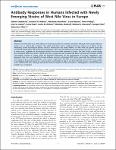Antibody Responses in Humans Infected with Newly Emerging Strains of West Nile Virus in Europe
Chabierski, Stefan
Makert, Gustavo R.
Kerzhner, Alexandra
Barzon, Luisa
Fiebig, Petra
Liebert, Uwe G.
Papa, Anna
Richner, Justin M.
Niedrig, Matthias
Diamond, Michael S.
Palu, Giorgio
Ulbert, Sebastian
Infection with West Nile Virus (WNV) affects an increasing number of countries worldwide. Although most human infections result in no or mild flu-like symptoms, the elderly and those with a weakened immune system are at higher risk for developing severe neurological disease. Since its introduction into North America in 1999, WNV has spread across the continental United States and caused annual outbreaks with a total of 36,000 documented clinical cases and ~1,500 deaths. In recent years, outbreaks of neuroinvasive disease also have been reported in Europe. The WNV strains isolated during these outbreaks differ from those in North America, as sequencing has revealed that distinct phylogenetic lineages of WNV concurrently circulate in Europe, which has potential implications for the development of vaccines, therapeutics, and diagnostic tests. Here, we studied the human antibody response to European WNV strains responsible for outbreaks in Italy and Greece in 2010, caused by lineage 1 and 2 strains, respectively. The WNV structural proteins were expressed as a series of overlapping fragments fused to a carrier-protein, and binding of IgG in sera from infected persons was analyzed. The results demonstrate that, although the humoral immune response to WNV in humans is heterogeneous, several dominant peptides are recognized.
Dateien zu dieser Publikation
Keine Lizenzangabe
Verwandte Publikationen
Anzeige der Publikationen mit ähnlichem Titel, Autor, Urheber und Thema.
-
2010-05-24ZeitschriftenartikelInducible costimulator (ICOS) blockade inhibits accumulation of polyfunctional T helper 1/T helper 17 cells and mitigates autoimmune arthritis Frey, Oliver; Meisel, Juliane; Hutloff, Andreas; Bonhagen, Kerstin; Bruns, Lisa; Kroczek, Richard; Morawietz, Lars; Kamradt, ThomasObjectives: Inducible costimulator (ICOS) and its ligand (ICOSL) regulate T and B cell responses. Glucose-6-phosphate isomerase (G6PI)-induced arthritis requires T and B lymphocytes. It was hypothesised that blocking ...
-
2016-02-26ZeitschriftenartikelLocal T/B cooperation in inflamed tissues is supported by T follicular helper-like cells Van, Dana Vu; Beier, Katja C.; Pietzke, Lea-Jean; Baz, Maysun S. Al; Feist, Randi K.; Gurka, Stephanie; Hamelmann, Eckard; Kroczek, Richard; Hutloff, AndreasAutoimmune diseases and other inflammatory conditions are characterized by large lymphocytic tissue infiltrates in which T and B cells can be found in close contact. Here, using a murine airway inflammation model, we compare ...
-
2013-04-15ZeitschriftenartikelGiardia duodenalis arginine deiminase modulates the phenotype and cytokine secretion of human dendritic cells by depletion of arginine and formation of ammonia Banik, Stefanie; Viveros, Pablo Renner; Seeber, Frank; Klotz, Christian; Ignatius, Ralf; Aebischer, ToniDepletion of arginine is a recognized strategy that pathogens use to evade immune effector mechanisms. Depletion depends on microbial enzymes such as arginases, which are considered virulence factors. The effect is mostly ...

